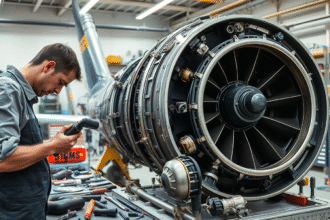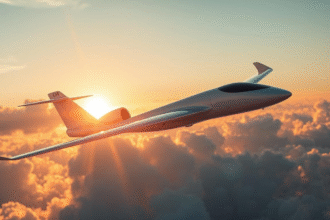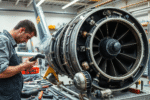As a professional pilot, I’ve learned how important airplane tires are for a safe landing on the runway. Landing safely is not just about the pilot’s skill. It also depends on the tires’ reliability and performance.
My years of experience handling various aircraft have given me insights into the world of airplane tires and their importance during the landing process.
tires working
The job of aircraft tires is critical. They must handle the stresses of landing, like the heat from friction and the impact of touching down.
Key Takeaways
- The performance of airplane tires is key for a safe landing.
- Aircraft tires are made to withstand landing stresses.
- The pilot’s role is essential for a smooth touchdown.
- Airplane tires are vital for the safety of the aircraft during landing.
- Knowing how aircraft tires work can help improve landing techniques.
The Critical Role of Aircraft Tires in Safe Landings
When an aircraft lands, its tires face huge stress. This shows how vital they are for safe landings. The forces during touchdown are big, and aircraft tires must handle them well. This ensures everyone on board is safe.
Forces at Play During Touchdown
During landing, touchdown forces can be very strong. They depend on the aircraft’s weight, speed, and how it descends. For example, a heavy plane or one landing too fast puts more stress on the tires.
| Factor | Impact on Tires |
| Aircraft Weight | Increased stress on tires |
| Speed | Higher speed increases friction and heat |
| Angle of Descent | Steeper angles increase impact forces |
Why Tire Performance Matters
Tire performance is key for safe landings. Good tires can manage the landing stresses, like friction and heat. It’s important to check and maintain aircraft tires regularly. This helps avoid failures that could be dangerous.
aircraft tires safe landings
Good tire performance means the plane can stop safely on the runway. This is very important, even more so in bad weather or on slippery runways.
Understanding Aircraft Tire Specifications
Aircraft tires are made to fit different planes, whether they’re for flying or military use. They’re designed to keep landings safe and smooth.
Commercial vs. Military Aircraft Tire Differences
Commercial plane tires are made for lots of takeoffs and landings. They’re tough and don’t wear out easily. Military plane tires, on the other hand, handle heavy loads and tough landings.
aircraft tire specifications
Size and Load Rating Classifications
Tires for planes come in many sizes. They’re picked based on how much the plane weighs and what it needs to do. The load rating tells us how much stress the tire can take during landing and moving.
Pressure Requirements and Monitoring
Keeping the right tire pressure is key for safety. If tires are too low, they wear out faster and might fail. If they’re too high, they can get damaged easily. So, checking the pressure often is very important.
Anatomy of Aircraft Tires: Built for Extreme Conditions
Aircraft tires are made to handle the tough landing conditions. They face high speeds and heavy loads. The tires have special parts that work together for safe landings.
Tread Design and Materials
The tread design is key for aircraft tires on the runway. Specialized tread patterns help with friction and prevent hydroplaning. The tires use high-strength rubber compounds to handle the landing forces.
Internal Structure and Reinforcement
The inside of aircraft tires has reinforcing materials like steel belts and polyester cords. These are important for landing stresses, including speed and weight.
| Component | Function | Material |
| Tread | Provides friction and traction | High-strength rubber |
| Sidewall | Supports tire structure | Reinforced rubber |
| Bead | Secures tire to rim | Steel and rubber |
The Science of Tires Working the Runway Surface
When an aircraft lands, its tires do a complex dance with the runway. They need to create enough friction to slow the plane down. At the same time, they must handle the stress of touching down.
Friction Coefficients on Various Runway Surfaces
The friction between tires and the runway is key for safe landings. Different surfaces, like asphalt or concrete, have different friction levels. For example, a grooved runway helps water escape, lowering hydroplaning risk.
Things like surface texture and dirt can change friction levels. This means the friction coefficient can vary a lot.
- Asphalt runways usually have more friction than concrete ones.
- Rougher surfaces tend to have better grip.
- Stuff like rubber or oil on the runway can make it slippery.
Heat Generation During Landing
Tires get hot when they rub against the runway during landing. This heat can damage the tires if not controlled. The plane’s speed, tire type, and braking system all play a part in how hot the tires get.
Hydroplaning Prevention Mechanisms
Hydroplaning happens when water gets between the tires and the runway. This can make the plane lose control. To stop this, runways have grooves to let water out. Keeping tires properly inflated also helps prevent hydroplaning.
Understanding how tires work with the runway helps us see the importance of safe landings. It’s all about friction, heat, and keeping the plane stable.
Landing Gear Systems and Tire Integration
A well-designed landing gear system is key for a smooth landing. It absorbs shock and spreads the aircraft’s weight evenly. The tires work with shock absorbers to ensure a gentle touchdown.
Shock Absorption Mechanisms
The shock absorption mechanism is vital in the landing gear system. It helps reduce the landing’s impact on the aircraft and its passengers. This mechanism combines hydraulic and mechanical parts, like oleo-pneumatic shock absorbers.
Oleo-pneumatic shock absorbers mix compressed gas and hydraulic fluid to soak up landing shock. This design is efficient at absorbing energy and lessens the aircraft’s structural stress.
Weight Distribution Across Multiple Tires
The aircraft’s weight is spread across several tires for better stability and to lower tire failure risk. The tire count and layout depend on the aircraft’s size and type.
Multiple tire setups are common in larger aircraft. They offer more stability and lower ground pressure. This is very important for planes landing on soft or unpaved runways.
| Aircraft Type | Number of Tires | Tire Size |
| Commercial Airliner | 12 | 49×17 |
| Business Jet | 6 | 22×6.75 |
| General Aviation | 3 | 15×6.00 |
My Pre-Flight Tire Inspection Protocol
Before every flight, I carefully check the aircraft tires. This is key for safe takeoffs.
Visual Inspection Techniques I Use
I start by looking for wear or damage on the tires. I check for uneven tread wear, cracks in the sidewalls, and bulging. I also look for debris in the tread that could harm the tire.
Pressure and Wear Indicators I Monitor
Next, I check the tire pressure. It must match the manufacturer’s specs for safety. I also watch the wear indicators. They show when the tread is too low and the tire needs to be replaced.
This careful check ensures the tires are ready for flight. It makes the flight safer for everyone.
Common Tire Failures and My Prevention Strategies
Preventing tire failures is key for safe landings. I’ve come up with strategies to do this. Tire failures can cause big problems, like losing control during landing or crashing.
I focus on understanding the common types of tire failures. Then, I take steps to prevent them.
Blowouts: Causes and Prevention
A tire blowout is very dangerous. It often happens because of overloading or underinflation. To stop blowouts, I check tire pressure regularly and look for wear signs.
“A well-maintained tire is the best way to avoid a blowout,” say aviation safety experts.
Tread Separation Issues
Tread separation happens when the tire tread comes off. This is usually because of excessive heat or manufacturing defects. I watch the tires closely for damage or uneven wear.
Regular rotation and proper inflation help prevent tread separation.
Foreign Object Damage Management
Foreign Object Damage (FOD) can harm tires, leading to failures. I check the runway before landing and report any dangers. “Being alert on the runway is as important as in the cockpit,” I always remember.
By knowing about common tire failures and using my prevention methods, I lower the chance of tire problems during landings. Regular checks, inspections, and being aware of hazards are my main strategies.
How I Handle Weather Challenges for Aircraft Tires
Aircraft tires face many weather challenges that affect landing safety. As a pilot, it’s key to know and adjust to different weather to keep tires safe and working well.
Winter Operations: Snow and Ice
In winter, snow and ice on the runway can harm aircraft tire performance. To fight these issues, I use:
- Advanced weather radar to predict and prepare for snowy or icy conditions
- Runway condition reports to check the runway’s state
- Specialized tire compounds for better grip on slippery surfaces
These steps help ensure safe landings in tough winter weather.
Wet Runway Procedures
Wet runways can cause tires to lose contact with the surface. To tackle wet runways, I:
- Keep an eye on weather reports for rain and runway moisture
- Adjust my landing to lower the hydroplaning risk
- Make sure my aircraft’s tires have enough tread for wet conditions
Being proactive helps lower the risks of landing on wet runways.
Extreme Temperature Considerations
Extreme temperatures can harm tire performance and life. To deal with this:
- I check tire pressure often, as it changes with temperature
- I make sure my aircraft’s tires fit the expected temperature range during flight
Knowing and preparing for extreme temperatures keeps tires in good shape and ensures safe landings.
Modern Innovations in Aircraft Tires Working Technology
Materials and monitoring systems are getting better in aircraft tires. The industry keeps changing to make flying safer and better. I’ll talk about new rubber compounds, smart tire systems, and what’s coming next.
Advanced Rubber Compounds
New rubber compounds are making aircraft tires last longer and work better. They can handle heat and wear better, which is key for safe landings. Some use nanomaterials to boost these qualities.
| Material | Heat Resistance | Wear Resistance |
| Traditional Rubber | Moderate | Good |
| Nanomaterial-Enhanced Rubber | High | Excellent |
Smart Tire Monitoring Systems
Smart tire systems are a big step forward. They give live updates on tire pressure and temperature. This helps keep tires in top shape and makes flying safer.
Future Developments I’m Watching
The future of aircraft tires looks bright. New materials and designs are being tested. For example, tires that adjust to different runways could make flying safer and more efficient.
Keeping an eye on these advancements helps the aviation industry. It leads to safer and better aircraft tires.
My Touchdown Technique for Optimal Tire Performance
Getting tires to perform well during landing needs a special touchdown technique. This method includes speed management, touchdown angle considerations, and crosswind landing adjustments.
Speed Management Strategies
Speed control is key during landing. I stick to a strict plan to keep my speed just right. This means monitoring airspeed and tweaking it as needed to stay in control.
“The key to a successful landing is being in control of your speed,” say seasoned pilots. The best speed is just above stall speed. It takes careful handling to keep it there.
Touchdown Angle Considerations
The touchdown angle is also very important. A shallow touchdown angle makes landings smoother, easing tire stress. I aim for the perfect angle, balancing steep and shallow.
This balance depends on knowing the aircraft well and the landing conditions.
Crosswind Landing Adjustments
For crosswind landings, I make special adjustments. I use the wing-low method or crabbing technique to line up with the runway. These methods help fight the wind, ensuring a straight landing.
Mastering crosswind landings takes practice and understanding how the aircraft reacts in wind.
In summary, my touchdown technique combines speed management, touchdown angle control, and crosswind adjustments. By focusing on these, I ensure my tires perform well and land safely.
Conclusion: The Unsung Heroes of Safe Landings
Aircraft tires are the unsung heroes of safe landings. They play a key role in keeping passengers and crew safe. We’ve looked into how they work, from their design to their performance on the runway.
It’s vital to maintain, inspect, and integrate tires with landing gear systems properly. This helps us understand the challenges of landing safely. We see how tires handle the forces of touchdown and affect their performance.
Modern tire technology, like advanced rubber and smart monitoring systems, boosts safety and performance. Following best practices for tire care helps avoid incidents. This ensures safe landings for everyone.
In summary, aircraft tires are vital for safe landings. Their importance should be recognized. By improving their performance, we keep air travel safe for all.
FAQ
What is the primary function of aircraft tires during landing?
Aircraft tires absorb the shock of landing. They provide traction and support the aircraft’s weight.
How do aircraft tires handle extreme temperatures?
Aircraft tires work in a wide temperature range. They are made to withstand cold and hot conditions.
What is the significance of proper tire pressure in aircraft?
Proper tire pressure is key for safe landings. Underinflated tires can cause reduced traction and stopping distance. They can also fail.
How do pilots inspect aircraft tires before flight?
Pilots visually check tires for wear, damage, or underinflation. They also use specialized gauges to check pressure.
What are some common causes of tire failures in aircraft?
Tire failures often come from underinflation, overloading, and damage from foreign objects. Regular checks and maintenance can prevent these issues.
What advancements have been made in aircraft tire technology?
New materials and smart tire systems have improved tire performance. They make tires safer and more durable.
How do crosswinds affect aircraft tire performance during landing?
Crosswinds require pilots to adjust their landing. Tires must handle sideways forces, which can be tough.
What role do aircraft tires play in hydroplaning prevention?
Tires are designed to prevent hydroplaning by providing good traction on wet runways. Pilots must be aware of the risks and take steps to avoid them.







